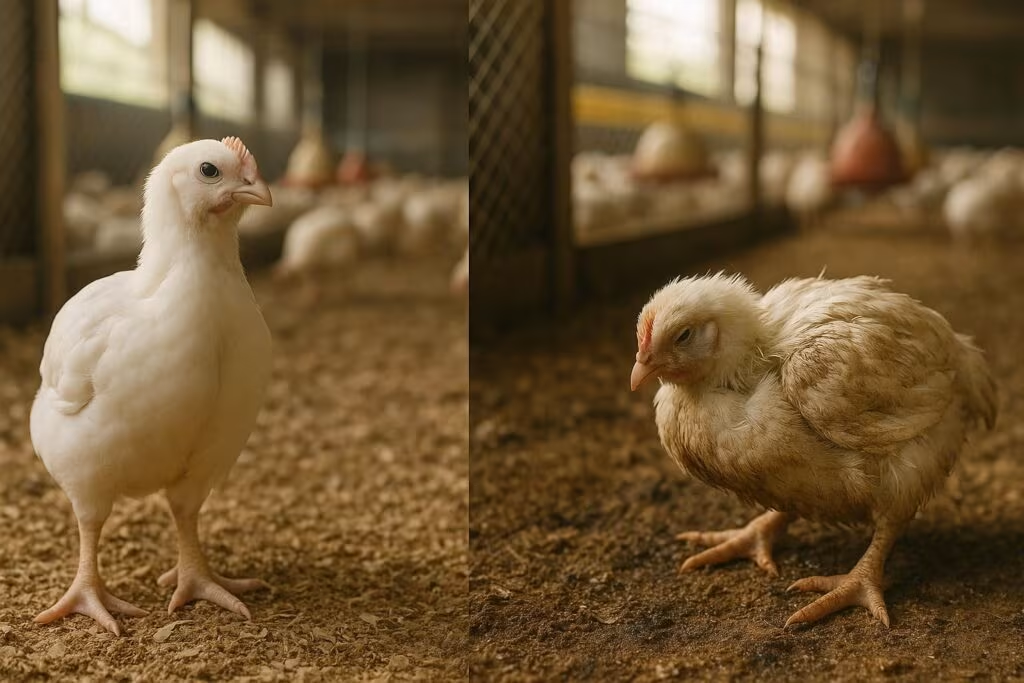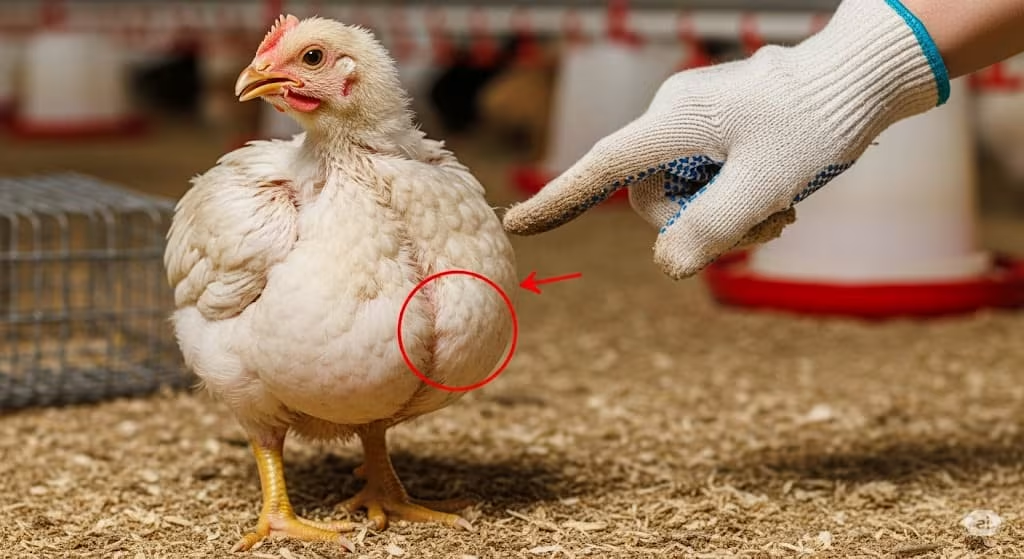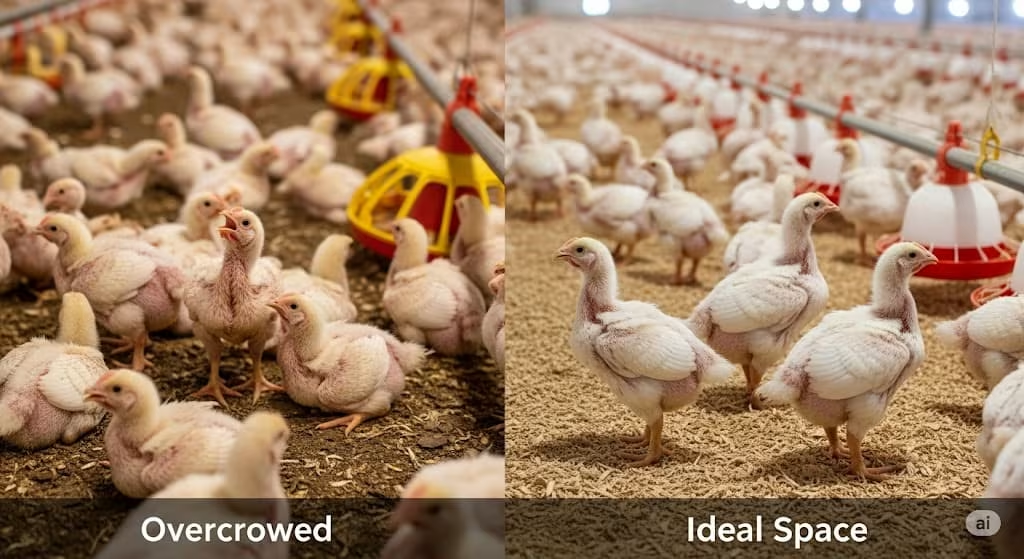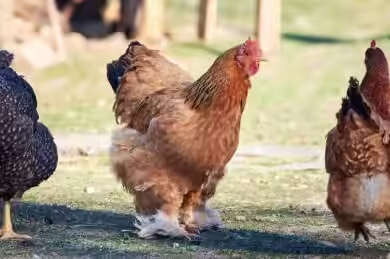Last updated on August 15, 2025
Broiler mortality at 4 weeks is often caused by preventable issues like disease, poor environment, or management errors.
What Kills Broilers at 4 Weeks?
So, what kills broilers at 4 weeks? Most deaths are caused by diseases like coccidiosis or ascites, poor ventilation, dirty water, extreme temperatures, or overcrowding.

Losing broilers at 4 weeks? I’ve been there. It’s frustrating, heartbreaking, and expensive. But here’s the good news — once I figured out what was killing my birds, I fixed it. And you can too. In this article, I’ll walk you through the 7 most common killers of 4-week-old broilers — and how to stop them before they wipe out your flock. For a broader understanding of raising these birds, check out our broiler chicken farming guide.
Why is four weeks such a turning point? At this age, your broilers are in hyper-drive. Their metabolism is roaring, they’re growing at an incredible pace, and their immune systems are still developing. This rapid growth, while desirable, also makes them incredibly vulnerable. Think of them as high-performance athletes in tiny, feathered bodies. Any little hiccup can throw them off balance. If you’re comparing them to other breeds, you might find our article on Noiler chicken vs. broiler chicken helpful.
The good news? Most broiler deaths at 4 weeks are preventable. You’re not failing; you’re learning.
Quick Solutions to Common 4-Week Broiler Killers:
- Coccidiosis: Keep litter dry and use medicated feed.
- Ascites (Water Belly): Ensure excellent ventilation and consistent temperatures.
- Sudden Death Syndrome (SDS): Manage feed intake and reduce stress.
- Temperature Stress: Maintain ideal temperatures (24-26°C / 75-78°F) and avoid drafts.
- Nutritional Deficiencies: Provide high-quality, balanced broiler feed.
- Poor Water Quality: Ensure clean, fresh water daily and regularly disinfect drinkers.
- Overcrowding: Provide at least 1.5 sq ft per broiler and monitor bird behavior.
Why Is the 4-Week Mark So Risky for Broilers?
Around four weeks, your broilers transition from chick starter to grower feed. Their space requirements increase, and their internal systems work overtime to keep up with rapid growth. This period tests their bodies and your management. Their fast metabolism means they’re burning through nutrients and oxygen quickly, making them susceptible to environmental and nutritional imbalances. If you’ve had issues with younger birds, you might also be interested in the top 10 reasons day-old chicks die early or why Cornish Cross chicks might be dying.
What Are the Signs Something’s Wrong in My Brooder or Coop?
Before a broiler dies, there are often subtle clues. Are birds huddled when they shouldn’t be? Is their poop looking off? Are some birds noticeably smaller or less active? These are all red flags. I always tell people to trust your gut – if something feels off, it probably is. Keep an eye out for changes in appetite, water consumption, posture, feather condition, or even unusual sounds. Early detection is your best defense.
1. Is Coccidiosis Killing Your Broilers?
Coccidiosis is a parasitic disease thriving in wet litter that devastates broiler guts, often causing bloody droppings and rapid weight loss. Preventing it involves maintaining dry conditions, using medicated feed, and strict hygiene.
Coccidiosis, caused by the Eimeria parasite, is one of the most common and devastating diseases for broilers, especially between three and five weeks of age. This nasty parasite thrives in wet, unsanitary litter, multiplying rapidly and infecting birds through ingestion. It attacks the gut lining, making it impossible for birds to absorb nutrients.
I once lost five birds in 48 hours because I didn’t spot coccidiosis early enough. The litter was a bit damp after a rainy week, and I thought I had it under control. Boy, was I wrong. If only I’d noticed the bloody droppings sooner!
What Are the Symptoms of Coccidiosis in Broilers?
The most tell-tale sign of coccidiosis is bloody droppings. If you see bright red or orange streaks in their poop, act immediately. Other symptoms I’ve seen include:
- Hunched posture, looking depressed
- Ruffled feathers
- Pale combs and wattles
- Significant and rapid weight loss or stunted growth
- Diarrhea, often watery and sometimes foamy
How Can I Prevent and Treat Coccidiosis?
Prevention is always better than cure, believe me. Focus on:
- Dry Litter: This is paramount. You need excellent ventilation to keep litter dry. Stir it regularly. I even use a small rake to aerate my litter daily, especially around the feeders and waterers where it tends to get damp.
- Medicated Feed: Many broiler starter and grower feeds come with coccidiostats. Always check your feed label.
- Routine Cleaning: Keep feeders and drinkers clean. I make sure to disinfect your coop thoroughly between flocks. For example, after one batch, I’ll remove all old litter, scrub the floors and walls with a poultry-safe disinfectant, and let it air out for a few days before the next chicks arrive.
- Biosecurity: Limit visitors and prevent wild birds or rodents from entering your coop. It’s like protecting your own home! I even have a dedicated pair of “coop shoes” that never leave the poultry area.
As Dr. Charles Hofacre, DVM, PhD, from Southern Poultry Research, emphasizes, “Good coccidiosis control and litter management are the two most important steps producers can take to prevent necrotic enteritis (NE) in flocks raised without antibiotics.” (Poultry Health Today). This highlights just how critical these practices are.
If you suspect an outbreak, please consult a vet or poultry expert for appropriate treatment, which often involves anticoccidial medications administered through water or feed. You might find our guide on must-have medications for broiler chicks useful for general preparedness. Don’t try to guess on this one.
2. Is Ascites (Water Belly) a Problem in Your Flock?
Ascites, or “water belly,” is a non-infectious condition where fluid builds up in the abdomen, caused by the heart and lungs struggling to supply enough oxygen to fast-growing broilers, often due to poor ventilation or cold stress.

Ascites, commonly known as “water belly,” is a non-infectious condition that often affects fast-growing broilers, especially at four weeks. It’s a build-up of fluid in the abdominal cavity, a direct result of the heart and lungs struggling to keep up with the body’s rapid oxygen demand. It’s a tough one to watch.
What Causes Ascites in 4-Week Broilers?
The primary culprit is insufficient oxygen. When your broilers grow quickly, their demand for oxygen skyrockets. If the ventilation in their coop is poor, or if they’re exposed to cold stress (which increases oxygen demand), their hearts and lungs become overworked. This leads to increased blood pressure in the lungs, fluid leakage, and eventually, fluid accumulation in the belly. High altitude can also contribute due to lower atmospheric oxygen. As Prof. G. Devegowda notes, “Ascites is a multifactorial syndrome, caused by interactions among environmental, nutritional and genetic factors.” (Benison Media).
Signs I’ve learned to watch for include:
- A visibly swollen, distended belly (it feels like a water balloon if you gently check)
- Difficulty breathing, often gasping or panting
- Cyanosis (a bluish discoloration of the comb and wattles)
- Lethargy and reluctance to move
- Sudden death, often found on their backs
How Can I Reduce the Risk of Ascites?
Managing ascites is all about providing optimal environmental conditions. This is where your management skills really shine:
- Excellent Ventilation: This is non-negotiable. You need fresh air constantly circulating to remove ammonia and provide oxygen. Don’t be afraid to use fans if necessary. For instance, in my coop, I installed exhaust fans that kick on automatically when ammonia levels rise or the temperature gets too high. You can find various options for poultry farming equipment for broilers that can help with ventilation.
- Consistent Temperature: Avoid sudden temperature drops or prolonged cold, which force birds to increase their metabolic rate to stay warm, thus increasing oxygen demand. I aim for a steady temperature, even overnight, to avoid stressing their systems.
- Moderate Growth Rate: While you want fast growth, sometimes slightly adjusting feed to slow down the initial growth burst can help their cardiovascular system catch up. I’ve found this can make a big difference, especially with very aggressive growth strains.
- Low Ammonia Levels: High ammonia in the air damages respiratory tracts, making birds more susceptible. Good ventilation helps here too. I know my ventilation is good if I can walk into the coop and not immediately smell a strong ammonia odor.
3. Is Sudden Death Syndrome (SDS) Affecting Your Broilers?
Sudden Death Syndrome (SDS) is a metabolic disorder causing healthy, fast-growing broilers to suddenly die, often flipping onto their backs. It’s linked to rapid growth, high energy intake, and stress triggers.
Sudden Death Syndrome (SDS), also known as “flip-over disease,” is exactly what it sounds like: a seemingly healthy broiler suddenly flips onto its back, often with wings spread, and dies within moments. It’s terrifying to witness because there are usually no prior symptoms. It’s one of those things that just makes you scratch your head.
Why Can Rapid Growth Lead to Sudden Death Syndrome?
SDS is most common in rapidly growing, male broilers between 3 and 6 weeks of age. While the exact cause isn’t fully understood, it’s believed to be a metabolic disorder related to the bird’s incredibly fast growth rate and high energy intake. It’s thought that an electrical disturbance in the heart occurs, leading to cardiac arrest. Stress triggers, like excitement or sudden loud noises, can often precipitate an episode.
How Can I Manage Feed and Stress to Prevent SDS?
While you can’t eliminate SDS entirely, you can significantly reduce its incidence. I’ve found these tips helpful:
- Feed Management:
- Avoid overfeeding, especially with highly energy-dense feeds. Instead of free-feeding all day, I sometimes limit access to feed for an hour or two in the middle of the day, which encourages more balanced growth.
- Consider “skip-a-day” feeding or providing feed for limited periods to slow down growth slightly and reduce metabolic stress.
- Ensure a balanced diet that supports skeletal and organ development alongside muscle growth. For tips on managing feed costs, see how to save money on broiler feed without cutting corners. If you’re planning for larger batches, our article on how many 50kg bags of feed for 100 broilers might be useful.
- Stress Reduction:
- Maintain consistent lighting schedules. I use a timer for my coop lights to ensure they get a regular dark period.
- Minimize sudden loud noises or disturbances in the coop. I try to keep things calm around my birds, avoiding shouting or sudden movements when I’m in there.
- Reduce handling stress.
- Ensure adequate space to prevent crowding and pecking.
4. Is Temperature Stress Killing Your Broilers?
Broilers are highly sensitive to temperature, with deviations from their ideal range of 24-26°C (75-78°F) causing significant stress, poor growth, and increased mortality.
Broilers are incredibly sensitive to temperature fluctuations, especially at four weeks. Their thermoregulation system is still maturing, and they can quickly succumb to either heatstroke or hypothermia. It’s like they’re Goldilocks – it has to be just right!
What’s the Ideal Temperature for 4-Week Broilers?
At four weeks, your broilers should be comfortable around 24-26°C (75-78°F). Any significant deviation can cause stress, leading to reduced feed intake, poor growth, and increased mortality.
How Can I Create Stable Heat and Ventilation?
- Use a Thermometer: Don’t guess! I always place multiple thermometers at bird level throughout the coop to monitor temperatures accurately. One near the brooder, one near the center, and one by an outer wall.
- Avoid Cold Drafts: Ensure your coop is free from direct drafts, especially at night. Seal cracks and use curtains if needed. I once had a small crack in the wall that created a draft, and I noticed the birds avoiding that corner. Sealing it up made a huge difference.
- Provide Shade in Hot Weather: If you’re in a hot climate, ensure adequate shade and good airflow. Consider misters or foggers if temperatures soar.
- Ventilation is Key: Again, ventilation plays a dual role. It removes heat and humidity in hot weather and ensures fresh air without creating cold spots in cooler weather. My first few batches always struggled with temperature because I didn’t have enough ventilation. It’s a delicate balance, but so worth it.
5. Are Nutritional Deficiencies Harming Your Broilers?
Invisible nutritional deficiencies can severely impact 4-week-old broilers, leading to issues like lameness or twisted necks due to their rapid growth demanding a precise balance of vitamins and minerals.
You might think you’re feeding them well, but invisible nutritional deficiencies can wreak havoc on 4-week-old broilers. Their rapid growth demands a precise balance of vitamins, minerals, and macronutrients. It’s not always about how much they eat, but what’s in what they eat.
What Key Vitamins and Minerals Do 4-Week Broilers Need?
- Vitamins:
- Vitamin E: Important for muscle and nerve health.
- Thiamine (B1): Crucial for metabolism.
- Other B vitamins: Essential for overall health and energy.
- Minerals:
- Calcium and Phosphorus: For strong bones.
- Selenium: Works with Vitamin E as an antioxidant.
Deficiencies can lead to issues like:
- Weak Legs/Lameness: Often due to insufficient calcium, phosphorus, or Vitamin D. I’ve seen birds struggle to stand or even develop splayed legs from this.
- Twisted Necks (Encephalomalacia): A Vitamin E deficiency can cause neurological issues, making them look like they’re stargazing.
- Perosis (Slipped Tendon): Can be caused by a deficiency in manganese or choline, leading to a slipped hock joint.
- Poor Weight Gain: A general sign of inadequate nutrition.
How Do I Choose the Right Feed for My Broilers?
- Quality Feed: Always invest in high-quality commercial broiler feeds. They are formulated to meet the specific needs of fast-growing birds. Don’t skimp here; it pays off. I always buy from reputable suppliers who can provide analysis reports if I ask.
- Transition Properly: Ensure a smooth transition from starter to grower feed around 2-3 weeks. Sudden changes can upset their digestive system. I usually mix the old and new feed for a few days to ease them into it. For more details on feed timing, see our broiler finisher feed timing guide.
- Freshness: Store feed in a cool, dry place to prevent spoilage and nutrient degradation. I keep mine in airtight containers, off the floor, to prevent moisture and pests.
- Supplementation (if needed): If you suspect a deficiency or are mixing your own feed, consult a nutritionist about appropriate vitamin/mineral supplements. You might also be interested in making a homemade broiler booster.
6. Is Poor Water Quality Affecting Your Broilers?
Poor water quality is a critical, often overlooked, factor that can rapidly spread diseases like E. coli and Salmonella through a broiler flock, leading to dehydration and mortality.
Water is often underestimated, but it’s arguably more critical than feed for broiler health. As Dr. Susan Watkins, Poultry Extension Specialist at the University of Arkansas, states, “Water is the most important nutrient for poultry.” (Mississippi State University Extension Service). Birds consume twice as much water as feed, and dirty or inadequate water can spread disease faster than anything else. I learned this the hard way when I had a mysterious illness sweep through my flock, and it turned out to be contaminated water. This highlights why clean water is more important than feed in poultry farming.
What Are the Signs of Contaminated or Inadequate Water?
- Slime in Pipes/Drinkers: A clear sign of bacterial or algal growth. If you run your finger along the inside of a water line and feel a slick film, that’s biofilm, and it’s a problem.
- Fecal Matter in Drinkers: Birds will often defecate in open waterers. I once saw a bird literally poop right into the waterer moments after I cleaned it – it happens!
- Unusual Odor or Taste: Though hard for us to detect, birds will avoid bad-tasting water.
- Low Flow Rate: If nipple drinkers aren’t providing enough water, your birds will dehydrate. I’ll often press on a few nipples to make sure the water flows freely.
- Reduced Water Consumption: If your birds aren’t drinking, something is definitely wrong. This is a primary sign of illness.
Dirty water can quickly introduce pathogens like E. coli and Salmonella into your flock, leading to gut infections and mortality.
What Are the Best Practices for Clean Drinking Water?
- Change Water Daily: For open waterers, empty, clean, and refill them daily. No excuses!
- Disinfect Containers Weekly: Scrub waterers with a brush and disinfectant at least once a week. I use a dedicated brush just for waterers.
- Clean Water Lines: If using nipple drinkers, flush and clean your water lines regularly to prevent biofilm buildup. I run a hydrogen peroxide solution through my lines every few weeks.
- Elevate Drinkers: Keep waterers at the birds’ back height to minimize contamination from litter and droppings. This simple trick saves so much cleaning time.
- Test Water Quality: If you’re on well water, I highly recommend testing it periodically for bacteria and mineral content. A local agricultural extension office can usually help with this.
7. Is Overcrowding Causing Problems in Your Broilers?
Overcrowding stresses broilers, leading to aggressive behaviors like feather pecking, uneven growth, and increased disease spread due to higher litter moisture and ammonia levels.

Overcrowding is a silent killer. It doesn’t just stress your birds; it creates a breeding ground for disease and aggressive behavior. Think of it like a crowded bus – everyone gets stressed and sick faster!
How Much Space Do 4-Week Broilers Need?
At four weeks, broilers need significantly more space than they did as chicks. A good guideline is at least 1.5 square feet per broiler. This might seem like a lot, but it’s crucial for their health and well-being. If you’re cramming 100 birds into a space meant for 50, you’re asking for trouble, and I’ve seen it lead to disaster. I learned this when I tried to push my limits with a batch, and the growth rates plummeted, and I had more losses.
What Behavior Clues Indicate Overcrowding?
- Feather Pecking/Cannibalism: Birds will start pecking at each other’s feathers, vents, or toes out of stress and boredom. It’s a clear sign they’re agitated.
- Huddling: Even when the temperature is right, overcrowded birds might huddle excessively, leading to heat stress for those in the middle.
- Thin Birds: Some birds will struggle to get enough feed and water due to competition. You’ll see a noticeable difference in size among your flock.
- Wet Litter: More birds in a smaller space mean more droppings and moisture, leading to wet litter and increased risk of coccidiosis and footpad issues.
- Increased Ammonia Smell: More birds, more waste, more ammonia. You’ll notice it immediately when you walk into the coop.
Poultry research also emphasizes that “While stocking density certainly influences broiler performance and welfare, research indicates that housing environment is extremely important.” (UGA Cooperative Extension). This reinforces that managing the overall environment is key, even beyond just space.
Bonus: What Should I Do Immediately After a Broiler Dies?
Finding a dead broiler is tough, but it’s also a critical moment for investigation. Don’t just discard the bird. This is your chance to learn and protect the rest of your flock.
What’s the Step-by-Step Process After a Broiler Dies?
- Remove the Bird: Immediately take the deceased bird out of the coop to prevent other birds from pecking at it and potentially spreading disease.
- Examine Signs: Before disposal, quickly inspect the bird for any external clues:
- Bloody Vent: Strong indicator of coccidiosis.
- Swollen Belly: Points to ascites.
- On its Back, Wings Spread: Classic SDS.
- Pale Comb/Wattles: Could indicate anemia or general illness.
- Any visible injuries or pecking marks?
- Keep Notes: Document the date, age of the bird, observed symptoms, and any other relevant details. This log will be invaluable if you need to call a vet or notice a pattern.
- Personal Anecdote: I once lost 5 birds in 48 hours because I didn’t spot coccidiosis early. If I had examined the first bird more closely and seen the bloody droppings, I could have started treatment sooner and saved the others. Every dead bird is a lesson, even if it’s a hard one.
When Should I Call a Vet or Seek a Lab Diagnosis?
If you experience:
- High Mortality: More than a few birds dying over a short period. For example, if you lose 3 birds in a day from a flock of 50, that’s a red flag.
- Unusual Symptoms: Signs you can’t identify or that seem severe.
- No Obvious Cause: You’ve checked all the common mistakes, but birds are still dying.
Don’t hesitate to contact a local poultry veterinarian or send a carcass to a diagnostic lab. They can perform a necropsy and identify the exact cause, saving your remaining flock. It’s an investment in your future success.
Final Take: Can You Beat Broiler Losses at 4 Weeks?
Broiler deaths at 4 weeks don’t have to be the end of your flock. Once you know what to watch for, you can stop problems early. You’ve got this!
What Mistakes Should I Avoid?
- Don’t ignore wet litter: It’s a coccidiosis haven.
- Never compromise on ventilation: Your birds need fresh air for their fast-growing bodies.
- Manage feed carefully: Don’t overfeed or use inappropriate diets.
- Maintain stable temperatures: Consistency is key.
- Prioritize water quality: It’s their most important nutrient.
- Provide ample space: Overcrowding invites stress and disease.
What Are Some Weekly Health Monitoring Tips?
Here’s a quick checklist to help you stay on top of things:
✅ 4-Week Broiler Health Checklist
- Litter Check: Is the litter dry and doesn’t smell strongly of ammonia?
- Water Quality: Is the water clean, cool, and clear? Are drinkers free of slime and droppings?
- Space: Do your birds have at least 1.5 sq ft of space each? Are they spread out comfortably?
- Droppings: Any signs of blood, unusual colors, or excessive wetness in droppings?
- Behavior: Are birds active and eating/drinking normally? No excessive huddling or pecking?
- Temperature: Is the coop temperature consistently in the 24-26°C (75-78°F) range?
- Feed Intake: Are they consuming feed at a steady rate, and does the feed look fresh?
You’re not failing. You’re learning. Every challenge in farming makes you a better, more experienced poultry keeper. Keep observing, keep learning, and your broilers will thrive. If this helped you, leave a comment or share with another farmer!
Frequently Asked Questions (FAQs)
What is the primary cause of broiler mortality at 4 weeks?
Most broiler deaths at 4 weeks are due to diseases like coccidiosis or ascites, coupled with environmental factors such as poor ventilation, dirty water, extreme temperatures, and overcrowding.
How can I prevent coccidiosis in my broilers?
Prevent coccidiosis by maintaining dry litter, using medicated feed, ensuring routine cleaning of feeders and drinkers, and implementing strong biosecurity measures.
What are the key signs of ascites (water belly) in broilers?
Look for a visibly swollen belly, difficulty breathing, bluish combs/wattles, lethargy, and sudden death, often with birds found on their backs.
What is the ideal temperature range for 4-week-old broilers?
The ideal temperature for 4-week-old broilers is around 24-26°C (75-78°F) to ensure their comfort and optimal growth.
How much space should 4-week broilers have to prevent overcrowding?
At four weeks, broilers need at least 1.5 square feet of space per bird to reduce stress, prevent aggressive behavior, and minimize disease spread.


